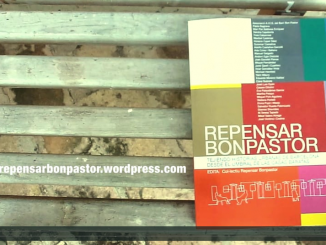
research


The Watchmen of Urban Conflict: OACU’s new webpage
This is the new toy that the Idle Magi brought yesterday, and that will cause sleepless nights for all the planners of gentrification and social peace: the new webpage of the Observatorio de Antropología del Conflicto Urbano (OACU)! You will find it in http://observatoriconflicteurba.org, it has a great media section, and you can try it now, by downloading the program of the I Ciclo “The social impact of architecture” that begins todaty january 8th, within the Master in Anthropology and Ethnography of University of Barcelona. Here you have more info, here the entire program. Thanks to the Magi and Long Live the Republic!…

Conference in Bolonia: the subjective dimensions of vulnerability
On october 5th, in Bolonia (Italy) the Network for the Evaluation of the Subjective Dimensions of Vulnerability (REDISUV) Chile-Europe will meet for the second time, after the foundational Conference in Paris. The repeated natural catastrophes in Chile made evident the need for a more systematic study about the subjectivities of the communities affected, which are always the product of particular social, economical and political conditions. The program of the conference includes papers concerning natural desasters, but also approaches to the “urban” vulnerability, caused by neoliberal policies as the one our group has been studying in Barcelona.
- Bolonia, Thursday september 5th, 10am-6pm: “Vite invisibili: dimensioni soggettive della vulnerabilità sociale“, program in PDF.
- Davide Olori (2013) “Taking over the center to oppose evictions: the case of the Inmuebles Recuperados Autogestionados en Santiago de Chile” [PDF, italian]. “The urgency for housing after the earthquake forced towards the aggregation of both informal organizations (as neighbours, relatives, co-workers) and formal ones (political, parties…), so causing dynamics of rupture and recomposition among interests, hierarchies, relationships…”
- Fabio Carnelli studied ethnographically the consequences of the earthquake in L’Aquila (central Italy) some years after: the “militarized” solution brought again to life the traumas, and increased the vulnerability of the population. See Sismografie on Il lavoro culturale webpage. And also Rita Ciccaglione’s article, one year after the earthquake in Emilia Romagna.
- Caterina Borelli jsut published on academia.edu her PhD thesis about Sarajevo: “La ciudad post-traumática” (see also this older post)
- Stefano Portelli (2013) “Spatial reordering and social pathology in the periphery of Barcelona: the social impact of urban transformation”, intervención al XXI congreso del International Social Theory Consortium, Copenhagen, June 26-27th [Coming soon!]

“Re-cordar” Can Ricart: to pass it back through the heart
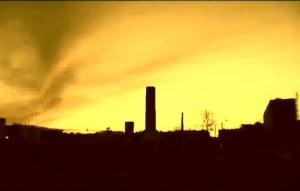 el desahucio
"bueno,
en primer lugar, te sientes echado, no querido, violentado. se rompe de pronto el universo ese repetitivo e invariable y, sin avisar, todo zozobra,
nada parece real.
incluso los cambios en el barrio,
los derribos,
no tienen ninguna connotación positiva, sólo resultaban amenazadores,
tristes.
trasladar una empresa es complicado.
es decir,
debería serlo, pq una empresa, por encima de todo,
la forman personas.
eso quiere decir q se trastorna –de pronto- toda la cosmogonía de tooodos los integrantes...
el desahucio
"bueno,
en primer lugar, te sientes echado, no querido, violentado. se rompe de pronto el universo ese repetitivo e invariable y, sin avisar, todo zozobra,
nada parece real.
incluso los cambios en el barrio,
los derribos,
no tienen ninguna connotación positiva, sólo resultaban amenazadores,
tristes.
trasladar una empresa es complicado.
es decir,
debería serlo, pq una empresa, por encima de todo,
la forman personas.
eso quiere decir q se trastorna –de pronto- toda la cosmogonía de tooodos los integrantes... 
Squatting in Europe
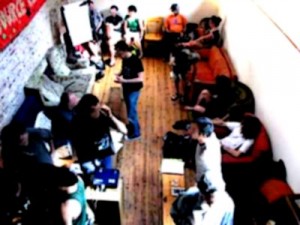 Squatting in Europe is a research network on the squatting movement in Europe. The origins of its members are very different: Brigthon, Madrid, Barcelona, Berlin, Copenhagen, Rotterdam, Roma, Catania, NewYork, Vermont, Amsterdam, Paris... so are their academic positions: some come from the universities, other are outside, some in between, and obviously shifting. From these diversities the members share a compromise and proximity with different expressions of the squatting movement, a practice of dialogue and reflection with the people who live these spaces, and an effort to publish works in free formats. Each meeting is held in a different city, always in squatted places, to share the debates with people living and using these spaces. Since 2009, the meetings have been in Madrid, Milan, London, Berlín, Amsterdam; the last one (december 2011) was in Copenhagen, in Bolsjefabrikken and Youth House. The results of the collective work and periodic meetings is obviously the enrichment of researches with the experience of the places visited, as well as the production of collective research from multiple perspectives.
Squatting in Europe is a research network on the squatting movement in Europe. The origins of its members are very different: Brigthon, Madrid, Barcelona, Berlin, Copenhagen, Rotterdam, Roma, Catania, NewYork, Vermont, Amsterdam, Paris... so are their academic positions: some come from the universities, other are outside, some in between, and obviously shifting. From these diversities the members share a compromise and proximity with different expressions of the squatting movement, a practice of dialogue and reflection with the people who live these spaces, and an effort to publish works in free formats. Each meeting is held in a different city, always in squatted places, to share the debates with people living and using these spaces. Since 2009, the meetings have been in Madrid, Milan, London, Berlín, Amsterdam; the last one (december 2011) was in Copenhagen, in Bolsjefabrikken and Youth House. The results of the collective work and periodic meetings is obviously the enrichment of researches with the experience of the places visited, as well as the production of collective research from multiple perspectives.
- Más información: Squatting in Europe SQEK manifesto - Squatting in Europe Research Agenda - Last meeting in Copenhagen - página en n-1
- The Bolsjefabrikken (candy factory) in Laerkevej, Copenhagen - where the last meeting was held - began a campaign to buy the building, under eviction [SEE PHOTOS][the webpage translated]
- Colin WARD (2002) Cotters and Squatters. Housing's hidden history. "If a man put up a cottage between sunset and sunrise and if he lit a fire on the hearth and sent smoke through a chimney, it was a recognised custom that he might remain in possession of the house although it was built on common land" [Download PDF]

Permanent Workshop on Urban Spaces
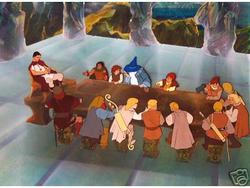 Our first workshop was on september 15th in the University of Barcelona: we plan to meet on the last thursday of every month, to share projects and reflections on the city and urban space, key issues in contemporary anthropology produced in the catalan capital. Participants in the workshop include: Omar Borrás,who is working on football among Cochabamba's immigrants in Barcelona; Andres Antebi, who is involved in a visual anthropology project on a small public square in Tangiers; Ariadna Mestre who studies Barcelona's Forat de la Vergonya as a theatralized space; Caterina Borelli who, after researching urban renewal of Raval, is now researching in Sarajevo; Marco Stanchieriwho works on the transformation of Vallcarca neighborhood; Muna Makhluffwho is doing her fieldwork in Barceloneta; Alba Marina who studies the nomadic network of "Salsa brava" in Barcelona; Miguel Fernández researching on the application of "civism" in Raval's calle Robadors; Marc Dalmau who focused on the impact of urban change of the Colonia Castells over the lifestyle of its inhabitants; and, obviously, Manuel Delgado for coordination and repression.
Our first workshop was on september 15th in the University of Barcelona: we plan to meet on the last thursday of every month, to share projects and reflections on the city and urban space, key issues in contemporary anthropology produced in the catalan capital. Participants in the workshop include: Omar Borrás,who is working on football among Cochabamba's immigrants in Barcelona; Andres Antebi, who is involved in a visual anthropology project on a small public square in Tangiers; Ariadna Mestre who studies Barcelona's Forat de la Vergonya as a theatralized space; Caterina Borelli who, after researching urban renewal of Raval, is now researching in Sarajevo; Marco Stanchieriwho works on the transformation of Vallcarca neighborhood; Muna Makhluffwho is doing her fieldwork in Barceloneta; Alba Marina who studies the nomadic network of "Salsa brava" in Barcelona; Miguel Fernández researching on the application of "civism" in Raval's calle Robadors; Marc Dalmau who focused on the impact of urban change of the Colonia Castells over the lifestyle of its inhabitants; and, obviously, Manuel Delgado for coordination and repression. 
A naval battle in Vallecas (Madrid): utopia as a device to build identity
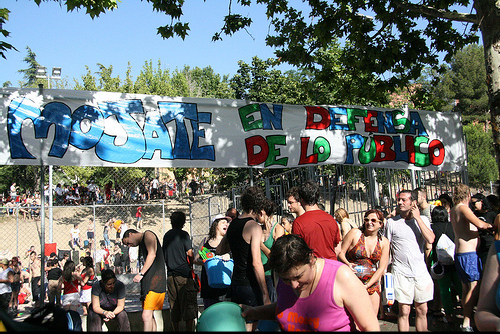 2011 will be the 30th year in which, in the outskirts of Madrid, and despite the ban of the City Council, the Naval Battle of Vallekas will take place: a popular and politically engaged fiesta that celebrates the independence of the neighborhood and its the proclamation of Vallecas as a seaport. Anthropologist Elizabeth Lorenzi, got involved in the neighborhood since 1998, and recently published an ehtnography of the fiesta (downloadable for free in PDF) in which, beginning from the Naval Battle, she analizes the urban and social transformations of Vallecas in the last decades, the role played in it by the grassroot movements, and the consequences of all this in the building and maintanance of the neighborhood identity. The Naval Battle celebrates and strenghtens the vallekanismo: the neighborhood as a frame for social mobilizations. Through this symbolic device, the long history of political demands, neighbors' struggles, anarchist movements of Vallecas, become part of the process of constructing the neighborhood identity.
2011 will be the 30th year in which, in the outskirts of Madrid, and despite the ban of the City Council, the Naval Battle of Vallekas will take place: a popular and politically engaged fiesta that celebrates the independence of the neighborhood and its the proclamation of Vallecas as a seaport. Anthropologist Elizabeth Lorenzi, got involved in the neighborhood since 1998, and recently published an ehtnography of the fiesta (downloadable for free in PDF) in which, beginning from the Naval Battle, she analizes the urban and social transformations of Vallecas in the last decades, the role played in it by the grassroot movements, and the consequences of all this in the building and maintanance of the neighborhood identity. The Naval Battle celebrates and strenghtens the vallekanismo: the neighborhood as a frame for social mobilizations. Through this symbolic device, the long history of political demands, neighbors' struggles, anarchist movements of Vallecas, become part of the process of constructing the neighborhood identity.

The forgotten mountain: everyday geopolitics in Sarajevo
 “Do you know when was it the last time I climbed on Trebević? February 1992. I used to go there every weekend with my father. I never went again. From that mountain 22 grenades fell onto the roof of our house. Now I see it everyday from my window, and I just want it to disappear”. Bojan, 30-years-old Sarajevan.[br]The inhabitants of Sarejevo (Bosnia-Herzegovina) don't climb any more on Trebević mountain, even if the war ended 15 years ago; the restaurants and panoramic terraces are destroyed, the cable car that connected it with the city never worked again, and, most of all, there are parts of it where there still could be landmines. But it's not lack of money the main reason why the city administration is keeping Trebević in this state of "no man's land": the divided city is useful for both nationalisms, and an invisible barrer separating "us" from "them" undermines the postwar coexistence project and the dream of a city that could be universal again.
“Do you know when was it the last time I climbed on Trebević? February 1992. I used to go there every weekend with my father. I never went again. From that mountain 22 grenades fell onto the roof of our house. Now I see it everyday from my window, and I just want it to disappear”. Bojan, 30-years-old Sarajevan.[br]The inhabitants of Sarejevo (Bosnia-Herzegovina) don't climb any more on Trebević mountain, even if the war ended 15 years ago; the restaurants and panoramic terraces are destroyed, the cable car that connected it with the city never worked again, and, most of all, there are parts of it where there still could be landmines. But it's not lack of money the main reason why the city administration is keeping Trebević in this state of "no man's land": the divided city is useful for both nationalisms, and an invisible barrer separating "us" from "them" undermines the postwar coexistence project and the dream of a city that could be universal again. 
Pedagogy of waters
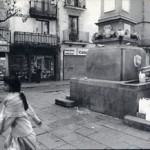
"I will tell you something about stories - he said They aren't just entertaiment, don't be fooled They are all we have, you see all we have to fight off illness and death You don't have anything if you don't have the stories Their evil is mighty, but it can't stand up to our stories So they try to destroy the stories let the stories be confused or forgotten They would like that. They would be happy because we will be defenseless then". (Leslie Marmon Silko, Ceremony, 1977)

A competition of ideas against the demolition of a popular neighborhood

The quality of life in Naples: between Pomigliano and Posillipo
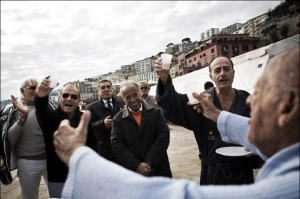 [/caption]
“An oasis of luxury in the capital of mafia" was the title chosen by a peruan newspaper in publishing this photo reportage about Naples' Circolo Posillipo. But in spite of many elements that might make us believe it, we can't pretend that Napols is just like a stereotype of a South American city, where the rich lock up in their golden bunkers, while in the streets the people shoot each other with guns. Partly because the members of Circolo Posillipo are not as rich as we could imagine; but mainly because Naples, as south american cities are, is a place far more complex than the unambiguous narrations we receive from the media, that now only see/sell the violent deaths, criminality, urbanistic and social chaos, while in the Nineties they only showed the monuments that were reopening, the dynamism of the new upper classes, and the rebirth of tourism. Even them the camorra controlled the neighborhoods, the peripheries were second-class places, the young people were beginning to assume crack and cocaine, hidden by the invisibility in which they were being kept. All these things, at that time, were not so fashionable as they are it now.
[/caption]
“An oasis of luxury in the capital of mafia" was the title chosen by a peruan newspaper in publishing this photo reportage about Naples' Circolo Posillipo. But in spite of many elements that might make us believe it, we can't pretend that Napols is just like a stereotype of a South American city, where the rich lock up in their golden bunkers, while in the streets the people shoot each other with guns. Partly because the members of Circolo Posillipo are not as rich as we could imagine; but mainly because Naples, as south american cities are, is a place far more complex than the unambiguous narrations we receive from the media, that now only see/sell the violent deaths, criminality, urbanistic and social chaos, while in the Nineties they only showed the monuments that were reopening, the dynamism of the new upper classes, and the rebirth of tourism. Even them the camorra controlled the neighborhoods, the peripheries were second-class places, the young people were beginning to assume crack and cocaine, hidden by the invisibility in which they were being kept. All these things, at that time, were not so fashionable as they are it now. 
The horizontal city: the neighborhoods of Cases Barates in Barcelona

Our research group began working in 2008 on the Casas Baratas de Bon Pastor, in the north periphery of Barcelona. It's a special neighborhood: more than 600 one-story houses, every one of them painted in a different color, in the middle of factories and industrial zones, on the shore of the Besós river. Built in 1929 in the middle of nowhere, to give housing to the immigrant factory workers (“murcianos y de la FAI”, they called it in those times), now it's an urban space more similar to a village than to a neighborhood of an occidental metropolis. A project of the Barcelona City Council, owner of all the houses, entails the “remodelation” of the whole area, through the demolition of the "casas baratas": the first 145 where demolished in 2007, a few months before we began our research. The inhabitants of the neighborhoods are suffering a series of “social pathologies” that go along the physical demolition of the houses: the social networks (neighbors, relatives...) are suffering the consequences of the urban transformation, and the "humanscape" of the neighborhood is changing maybe even faster than the physical landscape.
- READ THE REPORTS OF THE RESEARCH “Represalies i resistencies a les cases barates de Bon Pastor” i “Lluita social i memoria col.lectiva a les cases barates de Barcelona” (primer informe – segon informe)
- There is a webpage that we are using to work, but in which we are uploading the material we are producing: http://laciutathoritzontal.org